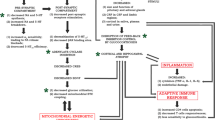Abstract.
In a recent study, we found a circadian rhythm in the response of central serotonin (5-HT)1A receptors to 8-hydroxy-2-(di-n-propylamino)tetralin (8-OH-DPAT). In the present study, the 8-OH-DPAT-induced 5-HT behavioural syndrome was examined in rats kept under continuous dark (DD) conditions for 6 days. The results revealed a circadian rhythm in the behavioural response to 8-OH-DPAT under DD conditions. The pattern of this rhythm was similar to that observed under the light-dark conditions, except for the phase delay that corresponds to the period of free-running rhythm. These results strongly suggest that the rhythm in the function of central 5-HT1A receptors is driven by the endogenous oscillator.
Similar content being viewed by others
Author information
Authors and Affiliations
Additional information
Received 12 August 1996; received after revision 8 October 1996; accepted 22 October 1996
Rights and permissions
About this article
Cite this article
Lu, JQ., Nagayama, H. Circadian rhythm in the function of central 5-HT1A receptors is endogenous in nature. CMLS, Cell. mol. life sci. 53, 224–226 (1997). https://doi.org/10.1007/PL00000594
Issue Date:
DOI: https://doi.org/10.1007/PL00000594




